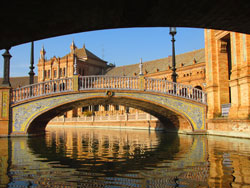Want to see a bullfight, watch beautiful flamenco dancers, travel to historic cathedrals, or experience another language? A trip to Spain may be in your future. Located in Europe on the Iberian Peninsula, the country is filled with different experiences.
According to the National Statistics Institute of Spain, the country is called home by about 47 million people. With culture, the Mediterranean Sea, the North Atlantic Ocean, mountain sides and cities galore, it almost seems unreasonable to not choose Spain as your spring break destination.
Toward the center of Spain and north of Seville lies the capital and largest city of the country: Madrid. Widely known for its soccer team, Madrid is populated by 3.3 million people. Dr. Elsa Lake, Spanish professor at the University, was once a native to Madrid.
“My brother and I lived in Madrid for almost two years,” Lake explained. “When I go to Spain, I always go to Barajas Airport, the international airport in Madrid.” Hotels are scattered across the big city with different options available for your price range. For the daytime, activities can range anywhere from touring the national art museum Museo Del Prado, or viewing beautiful architectural pieces such as the Almudena Cathedral tour.
One of Madrid’s most popular sites is the Palacio de Cristal (Crystal Palace) located in Retiro Park. The Palacio de Cristal is a large glass building originally built in 1887 as a greenhouse. If you visit on a sunny day, the glass building also acts as a prism, creating rainbows all around the structure.
Since Madrid has a series of festivals with attractions all year round, there is always an event to attend. Some of these festivals include concerts, cinema, theatre or dancing targeted toward young people.
One of Madrid’s most popular streets for night life is the Gran Vía. “Discotecas” (night clubs) and numerous bars exist on Gran Vía which attract many young crowds.
If you are more concerned with the culture than the party scene, take a drive down Calle Morería where you will find Corral de la Moreria. Here, you can experience Spanish cuisine while watching a highly regarded Flamenco show.
You can find a perfect combination of culture and party if you decide to attend a Real Madrid soccer match. Founded in 1902, the club is widely regarded as the best soccer team Europe has to offer. If you are planning to visit Spain over spring break, you are in luck as Real Madrid takes on Mallorca at home on March 17.
Another popular city destination is Barcelona. The city has a variety of tourist attractions such as beaches, bike tours, and the Picasso museum. Lake has been to this destination as well and claims, “Many young people love it. You can do almost anything in Barcelona.”
Sophomore communication major Tori Holmes stopped in Barcelona on a cruise and said one building in particular stood out to her. “I went and visited the Olympic stadium and saw where they held the 1992 Summer Olympics,” Holmes said. The Barcelona Olympic Games hosted “The Dream Team.” Lead by Michael Jordan, “The Dream Team” brought home one of the United States’ most cherished gold medals.
Sophomore health studies major, Caroline Keating, traveled to Madrid and Barcelona as well as with Granada, Cordoba and Toledo. “I took salsa lessons in Barcelona,” Keating said. “I really loved Cordoba, Toledo, and Granada because of the history. I would definitely recommend Granada because it was beautiful, clean and the shopping was really good. I only got to spend about half a day there but it was definitely my favorite,” she stated.
Granada is a smaller city located by the mountains, three rivers and the coast. This makes Granada a prime destination for both skiiers and beach goers. Granada is also home to a historic cathedral and architecture.
In concurrence with Keating, Lake adds, “I love the city of Granada, perhaps one of the most beautiful cities in Spain. You can see a mixture of cultures and architecture from Romanesque to gothic to Arabic influence.”
If it sounds like you may want to visit Spain for more than a week, the University does offer a study abroad summer program in Cádiz, Spain. Taking this option will not limit you to only Spain, but will let you travel anywhere in Europe. It is required in the summer program to stay in a house with a family; you can either see this as a bad side of the study abroad program or you can see it as a chance for you to improve your Spanish immensely as well as being more in tune with the culture.
Since Cádiz is only a summer program, sophomore Ayla Yildiz took it upon herself to coordinate her study abroad experience outside of the University’s borders. Through a third party program which the University affiliates with Yildiz planned her trip with The College Consortium for International Studies (CCIS). Yildiz studied during the 2012 fall semester in Sevilla, Spain and emersed herself into their daily life and culture by living with a host family.
“I learned how to take a siesta, in other words a nap, every day and I tried the craziest, but most delicious food,” she said about her trip. She attended cultural events such as a flamenco show and a bullfight.
Yildiz summed up her experience by saying, “It is simply a beautiful and breathtaking country and is an amazing location to travel to other countries as well, although I don’t know why you would want to leave.”
No matter what city you stay in, if you choose to travel to Spain, the country is sure to please. Whether it be traveling to Cádiz with MU, Seville, Madrid, Barcelona or Granada, tourism in these cities flourish for a reason. Perhaps while planning your spring break trip or even a future vacation, recall how much Spain has to offer and immerse yourself in the Spanish culture.
PHOTO COURTESY OF Ayla Y


